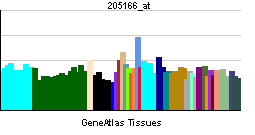CAPN5
| Calpain 5 | |||||||||||
|---|---|---|---|---|---|---|---|---|---|---|---|
| Identifiers | |||||||||||
| Symbols | CAPN5 ; FLJ46245; HTRA3; nCL-3 | ||||||||||
| External IDs | Template:OMIM5 Template:MGI HomoloGene: 31212 | ||||||||||
| |||||||||||
| RNA expression pattern | |||||||||||
 | |||||||||||
| More reference expression data | |||||||||||
| Orthologs | |||||||||||
| Template:GNF Ortholog box | |||||||||||
| Species | Human | Mouse | |||||||||
| Entrez | n/a | n/a | |||||||||
| Ensembl | n/a | n/a | |||||||||
| UniProt | n/a | n/a | |||||||||
| RefSeq (mRNA) | n/a | n/a | |||||||||
| RefSeq (protein) | n/a | n/a | |||||||||
| Location (UCSC) | n/a | n/a | |||||||||
| PubMed search | n/a | n/a | |||||||||
Calpain 5, also known as CAPN5, is a human gene.[1]
Calpains are calcium-dependent cysteine proteases involved in signal transduction in a variety of cellular processes. A functional calpain protein consists of an invariant small subunit and 1 of a family of large subunits. CAPN5 is one of the large subunits. Unlike some of the calpains, CAPN5 and CAPN6 lack a calmodulin-like domain IV. Because of the significant similarity to Caenorhabditis elegans sex determination gene tra-3, CAPN5 is also called as HTRA3.[1]
References
Further reading
- Vanderklish PW, Bahr BA (2001). "The pathogenic activation of calpain: a marker and mediator of cellular toxicity and disease states". International journal of experimental pathology. 81 (5): 323–39. PMID 11168679.
- Sato K, Kawashima S (2002). "Calpain function in the modulation of signal transduction molecules". Biol. Chem. 382 (5): 743–51. PMID 11517927.
- Bonaldo MF, Lennon G, Soares MB (1997). "Normalization and subtraction: two approaches to facilitate gene discovery". Genome Res. 6 (9): 791–806. PMID 8889548.
- Dear N, Matena K, Vingron M, Boehm T (1997). "A new subfamily of vertebrate calpains lacking a calmodulin-like domain: implications for calpain regulation and evolution". Genomics. 45 (1): 175–84. doi:10.1006/geno.1997.4870. PMID 9339374.
- Mugita N, Kimura Y, Ogawa M; et al. (1997). "Identification of a novel, tissue-specific calpain htra-3; a human homologue of the Caenorhabditis elegans sex determination gene". Biochem. Biophys. Res. Commun. 239 (3): 845–50. doi:10.1006/bbrc.1997.7571. PMID 9367857.
- Matena K, Boehm T, Dear N (1998). "Genomic organization of mouse Capn5 and Capn6 genes confirms that they are a distinct calpain subfamily". Genomics. 48 (1): 117–20. PMID 9503024.
- Strausberg RL, Feingold EA, Grouse LH; et al. (2003). "Generation and initial analysis of more than 15,000 full-length human and mouse cDNA sequences". Proc. Natl. Acad. Sci. U.S.A. 99 (26): 16899–903. doi:10.1073/pnas.242603899. PMID 12477932.
- Ota T, Suzuki Y, Nishikawa T; et al. (2004). "Complete sequencing and characterization of 21,243 full-length human cDNAs". Nat. Genet. 36 (1): 40–5. doi:10.1038/ng1285. PMID 14702039.
- Waghray A, Wang DS, McKinsey D; et al. (2004). "Molecular cloning and characterization of rat and human calpain-5". Biochem. Biophys. Res. Commun. 324 (1): 46–51. doi:10.1016/j.bbrc.2004.09.012. PMID 15464980.
- Gerhard DS, Wagner L, Feingold EA; et al. (2004). "The status, quality, and expansion of the NIH full-length cDNA project: the Mammalian Gene Collection (MGC)". Genome Res. 14 (10B): 2121–7. doi:10.1101/gr.2596504. PMID 15489334.
- González A, Sáez ME, Aragón MJ; et al. (2006). "Specific haplotypes of the CALPAIN-5 gene are associated with polycystic ovary syndrome". Hum. Reprod. 21 (4): 943–51. doi:10.1093/humrep/dei443. PMID 16396936.
- Sáez ME, Martínez-Larrad MT, Ramírez-Lorca R; et al. (2007). "Calpain-5 gene variants are associated with diastolic blood pressure and cholesterol levels". BMC Med. Genet. 8: 1. doi:10.1186/1471-2350-8-1. PMID 17227582.
| This protein-related article is a stub. You can help Wikipedia by expanding it. |